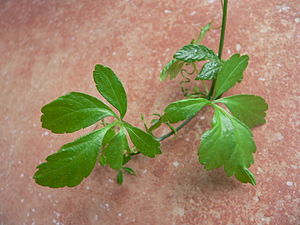Note: This is a project under development. The articles on this wiki are just being initiated and broadly incomplete. You can Help creating new pages.
Difference between revisions of "Gynostemma pentaphyllum - Jiaogulan"
(→Parts Used) |
|||
| Line 9: | Line 9: | ||
==Parts Used== | ==Parts Used== | ||
| − | {{Parts Used|Leaves | + | {{Parts Used|Leaves}} |
==Chemical Composition== | ==Chemical Composition== | ||
Revision as of 12:04, 11 May 2018
Jiaogulan also called Gynostemma pentaphyllum literally "stranded blue plant" is a dioecious, herbaceous climbing vine of the family Cucurbitaceae indigenous. it normally grows in China, northern Vietnam, southern Korea, and Japan.
Contents
- 1 Uses
- 2 Parts Used
- 3 Chemical Composition
- 4 Common names
- 5 Properties
- 6 Habit
- 7 Identification
- 8 List of Ayurvedic medicine in which the herb is used
- 9 Where to get the saplings
- 10 Mode of Propagation
- 11 How to plant/cultivate
- 12 Commonly seen growing in areas
- 13 Photo Gallery
- 14 References
- 15 External Links
Uses
blood sugar, cholesterol, blood pressure, nervous tension, peptic ulcer, asthma, bronchitis, diabetes, cardiovascular, cancer
Parts Used
Chemical Composition
Phenolic, saponin, and flavonoid[1]
Common names
| Language | Common name |
|---|---|
| Kannada | |
| Hindi | |
| Malayalam | |
| Tamil | |
| Telugu | |
| Marathi | NA |
| Gujarathi | NA |
| Punjabi | NA |
| Kashmiri | NA |
| Sanskrit | |
| English | Agrimony |
Properties
Reference: Dravya - Substance, Rasa - Taste, Guna - Qualities, Veerya - Potency, Vipaka - Post-digesion effect, Karma - Pharmacological activity, Prabhava - Therepeutics.
Dravya
Rasa
Guna
Veerya
Vipaka
Karma
Prabhava
Habit
Identification
Leaf
| Kind | Shape | Feature |
|---|---|---|
| Simple | The leaves are divided into 3-6 toothed leaflets, with smaller leaflets in between |
Flower
| Type | Size | Color and composition | Stamen | More information |
|---|---|---|---|---|
| Unisexual | 2-4cm long | Yellow | 5-20 | Flowers Season is June - August |
Fruit
| Type | Size | Mass | Appearance | Seeds | More information |
|---|---|---|---|---|---|
| 7–10 mm (0.28–0.4 in.) long pome | clearly grooved lengthwise, Lowest hooked hairs aligned towards crown | With hooked hairs | {{{6}}} |
Other features
List of Ayurvedic medicine in which the herb is used
- Vishatinduka Taila as root juice extract
Where to get the saplings
Mode of Propagation
How to plant/cultivate
Requires a rich well-drained but moisture-retentive soil in a warm sheltered position in partial shade[3]
Commonly seen growing in areas
Tall grasslands, meadows, Borders of forests and fields.
Photo Gallery
References
External Links
- Pages that are stubs
- Ayurvedic Herbs known to be helpful to treat blood sugar
- Ayurvedic Herbs known to be helpful to treat cholesterol
- Ayurvedic Herbs known to be helpful to treat blood pressure
- Ayurvedic Herbs known to be helpful to treat nervous tension
- Ayurvedic Herbs known to be helpful to treat peptic ulcer
- Ayurvedic Herbs known to be helpful to treat asthma
- Ayurvedic Herbs known to be helpful to treat bronchitis
- Ayurvedic Herbs known to be helpful to treat diabetes
- Ayurvedic Herbs known to be helpful to treat cardiovascular
- Ayurvedic Herbs known to be helpful to treat cancer
- Herbs with Leaves used in medicine
- Herbs with common name in English
- Habit - Herb
- Index of Plants which can be propagated by Seeds
- Herbs that are commonly seen in the region of Tall grasslands
- Herbs that are commonly seen in the region of meadows
- Herbs that are commonly seen in the region of Borders of forests and fields
- Herbs
